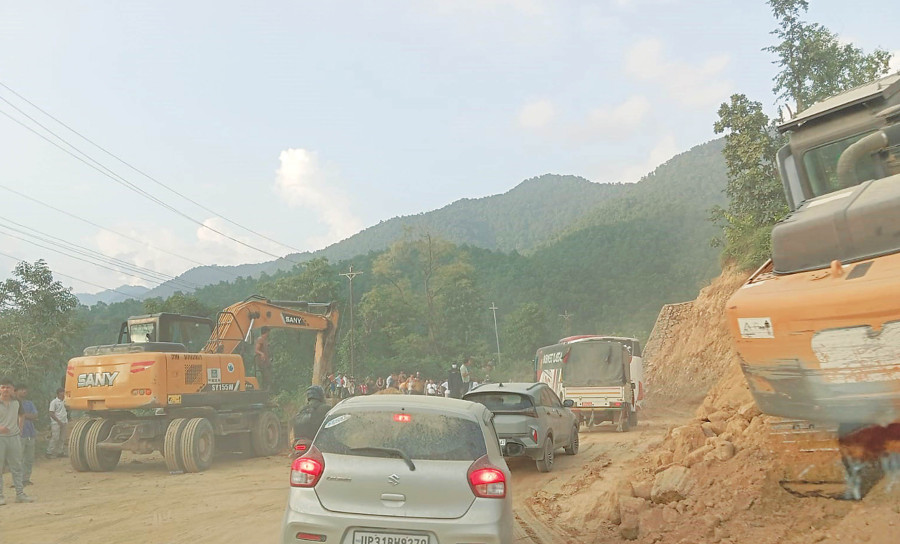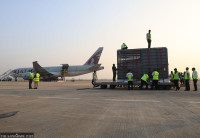Lumbini Province
‘Unbearable’: Travellers struggle to negotiate the Narayanghat-Butwal road
Ongoing expansion works, coupled with landslides, have turned travel on this essential route into a harrowing journey.
Nabin Paudel
On September 30, a section of the busy Narayanghat-Butwal road in Bardaghat Municipality-4, of Nawalparasi Bardaghat Susta West, collapsed near Khusarni Khola. The incident, which happened at around 4 pm, also brought down a high-tension electricity pole, further aggravating the situation.
By early morning on October 1, authorities managed to open the road for one-way traffic after an overnight repair. But overwhelming traffic still caused massive delays, with travellers spending up to four hours to cover just 15 kilometres between Dumkibas and Bardaghat.
According to Scheme Shrestha, chief district officer of the district, this route is vital for those heading to their hometowns to celebrate Dashain. However, a subsequent collapse at the same location on the evening of October 4, again disrupted traffic.
As authorities hurriedly filled the sunken section to allow light vehicles to pass, heavier traffic soon followed, causing the road to cave in yet again. This back-and-forth between road repairs and collapses has frustrated travellers and created immense challenges for those reliant on this critical highway.
For years, the Narayanghat-Butwal road has been a nightmare for commuters, particularly during the monsoon season. The ongoing expansion works, coupled with landslides and deep potholes, have turned travel on this essential route into a harrowing journey.
“The highway is always dusty or muddy, making the travel unbearable,” says Ansu Bhattarai, a local from Daunne, Vinayitriveni Rural Municipality-2. “It took me two hours to cover the seven kilometres between Daunne and Bardaghat. The traffic jams, worsened by long-haul vehicles, are making things very difficult for us.”
Ansu’s story echoes the sentiments of countless others who find themselves stuck for hours in long traffic queues with no access to basic necessities like water, food, or restrooms. The highway, flanked by steep hills and dense forests, leaves travellers with no escape during emergencies.
Bibek Poudel, who lives in Kathmandu, had hoped to return to Bardaghat to celebrate Dashain with his family but was deterred by the road conditions. “It’s uncertain how many landslides or road collapses we’ll face while travelling home,” he shares over the phone. “Flights are also either unavailable or exorbitantly expensive, leaving ordinary people like us with no choice but to endure this unsafe road journey.”
The 15-kilometre Daunne stretch of the highway has become particularly notorious for its frequent landslides and road collapses. Even minor rainfall turns the road into a treacherous path of muddy and slippery terrain, complicating the situation for drivers. A single broken-down vehicle often brings the entire stretch to a standstill, with traffic reduced to one-way movement.
Kamalaraj Jaishi from Kawasoti-17 experienced this firsthand when he embarked on a 60-kilometre journey from Danda to Bhumahi. The trip, which normally takes a couple of hours to cover, stretched to six hours, with four hours spent negotiating the Daunne section alone.
“Travelling on this road has become unbearable, but what choice do we have?” he says. “Before the road expansion began, there were no such collapses. Now, following expansion works, landslides and road subsidence have become common. Lack of an alternative route and the delayed repairs only worsen the problem.”
According to technical experts investigating the road collapse on September 30, heavy rainfall and the collapse of the high-tension electricity pole contributed to water accumulation, which seeped into the ground, weakening the road’s foundation.

Shashank Mishra, chief of the Narayanghat-Butwal road expansion project, attributes the recurrent collapses to softening soil and water seepage.
“We’ve seen several days of heavy rain, which caused water to pool above the road,” Mishra explains. “This, combined with the steep terrain, led to the road subsiding toward the slope. We are working to drain the water, and once the rains subside, we expect the situation to improve.”
Despite the repeated efforts to maintain the road, lack of a sustainable solution has left commuters in a state of constant distress. Plans to upgrade and build an alternative route connecting Dumkibas in East Nawalparasi with Bardaghat Municipality-2 have been stalled for years, prolonging the suffering of those who rely on this key transport corridor.
As the road to Bardaghat continues to sink, the hopes of travellers too sink with it—especially for those like Vivek, longing to reunite with their families during the festive season. Until a long-term solution is implemented, the Narayanghat-Butwal highway will remain a perilous journey, leaving thousands at the mercy of nature and inadequate infrastructure they must navigate every day.
The locals and the travellers suffered a lot due to the slow progress of the Butwal-Narayanghat road widening project which had the second extended deadline expire on July 22.




 6.12°C Kathmandu
6.12°C Kathmandu















